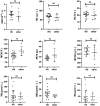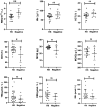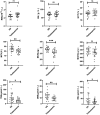Genetic screening strategy for children with hereditary spherocytosis in Jiangxi Province of China
- PMID: 39895984
- PMCID: PMC11782210
- DOI: 10.3389/fped.2024.1487121
Genetic screening strategy for children with hereditary spherocytosis in Jiangxi Province of China
Abstract
Objective: This study aims to provide a comprehensive summary of the clinical phenotypic characteristics of children with anemia of unknown etiology, particularly focusing on the early detection of hereditary spherocytosis (HS) and exploring genetic screening strategies for this condition in childhood.
Methods: The study included children with anemia whose underlying cause could not be definitively identified through routine clinical diagnosis. Clinical data was collected and genetic diagnosis of HS was confirmed using next-generation sequencing. Statistical analysis was conducted to evaluate the clinical characteristics of children with HS.
Results: A total of thirty children with unexplained anemia were included in the study, resulting in a gene detection diagnostic rate of 80%. This included the identification of five non-HS-related congenital anemia genes (16.66%, 5/30) and nineteen cases of hereditary spherocytosis (HS). Upon initial diagnosis, the clinical features of HS were not significantly distinct compared to other forms of anemia.
Conclusion: In Jiangxi, China, our strategy of genetic screening for these children is feasible after excluding the common causes of anemia, such as nutritional anemia, G-6-PD deficiency, thalassemia, autoimmune hemolytic anemia, and myelopoietic abnormalities in children. This is an exploration to establish a genetic screening strategy for children with HS, and more detailed genetic screening strategies need to be further studied and explored. Next-generation sequencing remains the main method for the diagnosis and differential diagnosis of HS.
Keywords: China; Jiangxi province; children; genetic screening strategy; hereditary spherocytosis.
© 2025 Wu, Xu, Wan, Chen, Ye and Wang.
Conflict of interest statement
The authors declare that the research was conducted in the absence of any commercial or financial relationships that could be construed as a potential conflict of interest.
Figures




Similar articles
-
Clinical and genetic diagnosis for 26 paitents with hereditary spherocytosis.Zhong Nan Da Xue Xue Bao Yi Xue Ban. 2023 Apr 28;48(4):565-574. doi: 10.11817/j.issn.1672-7347.2023.220390. Zhong Nan Da Xue Xue Bao Yi Xue Ban. 2023. PMID: 37385619 Free PMC article. Chinese, English.
-
Genetic mutation analysis of hereditary spherocytosis in Guangxi Zhuang Autonomous Region.J Hematop. 2023 Jun;16(2):95-101. doi: 10.1007/s12308-023-00545-8. Epub 2023 May 5. J Hematop. 2023. PMID: 38175446
-
The diagnostic protocol for hereditary spherocytosis-2021 update.J Clin Lab Anal. 2021 Dec;35(12):e24034. doi: 10.1002/jcla.24034. Epub 2021 Oct 24. J Clin Lab Anal. 2021. PMID: 34689357 Free PMC article. Review.
-
Clinical and genetic characteristics of Chinese pediatric and adult patients with hereditary spherocytosis.Orphanet J Rare Dis. 2024 Jul 24;19(1):278. doi: 10.1186/s13023-024-03290-y. Orphanet J Rare Dis. 2024. PMID: 39044243 Free PMC article.
-
Identification of a De Novoc.1000delA ANK1 mutation associated to hereditary spherocytosis in a neonate with Coombs-negative hemolytic jaundice-case reports and review of the literature.BMC Med Genomics. 2021 Mar 11;14(1):77. doi: 10.1186/s12920-021-00912-3. BMC Med Genomics. 2021. PMID: 33706756 Free PMC article. Review.
References
LinkOut - more resources
Full Text Sources
Miscellaneous

